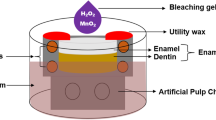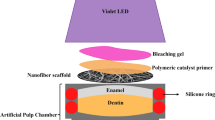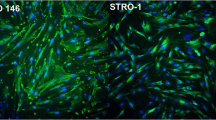Abstract
Gels with high concentrations of hydrogen peroxide (H2O2) have been associated with cytotoxicity and consequent post-bleaching tooth sensitivity. This study assessed the bleaching efficacy (BE) and cytotoxicity (CT) of bleaching gels with low concentrations of H2O2 containing manganese oxide (MnO2) and photocatalyzed with violet LED (LEDv). The following groups were established: G1: no treatment (negative control, NC); G2: 35% H2O2 (positive control, PC); G3: LEDv; G4: 10% H2O2; G5: 6% H2O2; G6: 10% H2O2 + MnO2 + LEDv; G7: 6% H2O2 + MnO2 + LEDv. To analyze BE, standardized enamel/dentin discs (E/DDs) were subjected to the bleaching procedures for 45 min (1 session). The color change was determined before and after performing the bleaching protocols (ΔE00; ΔWI). To analyze CT, the E/DDs were adapted to artificial pulp chambers, and the extracts (culture medium + diffused gel components) were applied to cultured odontoblast-like MDPC-23 cells. Then, the cells were assessed concerning their viability (VB), oxidative stress (OxS), and Live/Dead. The amount of H2O2 diffused was also determined (ANOVA/Tukey; p < 0.05). Cell viability decreased in all bleached groups compared to G1 (NC; p < 0.05). The cells in G6 and G7 presented higher viability than in G2, G4, and G5 (p < 0.05). The BE in G7 was similar to G2 (PC; p < 0.05). The lowest OxS and H2O2 diffusion values were found in G6 and G7, compared to the other bleached groups (G2, G4, and G5; p < 0.05). The 6% H2O2 bleaching gel (G7) submitted to both methods of catalysis (MnO2 + LEDv) caused only a mild cytotoxicity and maintained the excellent esthetic outcome promoted by in-office conventional tooth bleaching.



Similar content being viewed by others
Data Availability
All procedures that involved the use of bovine teeth for scientific research purposes are in compliance with the precepts of Law No.11.794, of October 8, 2008, of Decree No 6.899, of July 15, and with the rules edited by the National Council of Control of Animal Experimentation (“Conselho Nacional de Controle da Experimentação Animal”) (CONCEA).
References
Suty H, De Traversay C, Cost M (2004) Applications of advanced oxidation processes: present and future. Water Sci Technol 49(4):227–233
Reis A, Kossatz S, Martins GC, Loguercio AD (2013) Efficacy of and effect on tooth sensitivity of in-office bleaching gel concentrations: a randomized clinical trial. Oper Dent 38(4):386–393. https://doi.org/10.2341/12-140-C
De Paula EA, Nava JA, Rosso C, Benazzi CM, Fernandes KT, Kossatz S, Loguercio AD, Reis A (2015) In-office bleaching with two- and seven-day intervals between clinical sessions: a randomized clinical trial on tooth sensitivity. J Dent 43(4):424–429. https://doi.org/10.1016/j.jdent.2014.09.009
De Oliveira Duque CC, Soares DG, Basso FG, Hebling J, de Souza Costa CA (2014) Bleaching effectiveness, hydrogen peroxide diffusion, and cytotoxicity of a chemically activated bleaching gel. Clin Oral Investig 18(6):1631–1637. https://doi.org/10.1007/s00784-013-1147-4
De Oliveira Duque CC, Soares DG, Basso FG, Hebling J, De Souza Costa CA (2017) Influence of enamel/dentin thickness on the toxic and esthetic effects of experimental in-office bleaching protocols. Clin Oral Investig 21(8):2509–2520. https://doi.org/10.1007/s00784-017-2049-7
Markowitz K (2010) Pretty painful: Why does tooth bleaching hurt? Med Hypotheses 74(5):835–840. https://doi.org/10.1016/j.mehy.2009.11.044
Roderjan DA, Stanislawczuk R, Hebling J, de Souza Costa CA, Reis A, Loguercio AD (2015) Response of human pulps to different in-office bleaching techniques: preliminary findings. Braz Dent J 26(3):242–248. https://doi.org/10.1590/0103-6440201302282
Bersezio C, Estay J, Jorquera G, Peña M, Araya C, Angel P, Fernández E (2019) Effectiveness of dental bleaching with 37.5% and 6% hydrogen peroxide and its effect on quality of life. Oper Dent 44(2):146–155. https://doi.org/10.2341/17-229-C
Bersezio C, Pardo C, Miranda S, Medeiros Maran B, da JorqueraSilva GRA Jr, Tonetto RodriguesFernández ME (2021) Evaluation of the effectiveness in teeth whitening of a single session with 6% hydrogen peroxide Laser/LED system. Photodiagnosis Photodyn Ther 36:102532. https://doi.org/10.1016/j.pdpdt.2021.102532
Bersezio C, Martín J, Angel P, Bottner J, Godoy I, Avalos F, Fernández E (2019) Teeth whitening with 6% hydrogen peroxide and its impact on quality of life: 2 years of follow-up. Odontology 107(1):118–125. https://doi.org/10.1007/s10266-018-0372-3
Torres CR, Wiegand A, Sener B, Attin T (2010) Influence of chemical activation of a 35% hydrogen peroxide bleaching gel on its penetration and efficacy - in vitro study. J Dent 38(10):838–846. https://doi.org/10.1016/j.jdent.2010.07.002
Travassos AC, Torres CR, Borges AB, Barcellos DC (2010) In vitro assessment of chemical activation efficiency during in office dental bleaching. Oper Dent 35(3):287–294. https://doi.org/10.2341/09-256-L
Torres CR, Souza CS, Borges AB, Huhtala MF, Caneppele TM (2013) Influence of concentration and activation on hydrogen peroxide diffusion through dental tissues in vitro. Sci World J 2013:193241. https://doi.org/10.1155/2013/193241
Soares DG, Marcomini N, Duque CCO, Bordini EAF, Ortecho-Zuta U, Basso F, Hebling J, de Souza Costa CA (2019) Increased whitening efficacy and reduced cytotoxicity are achieved by the chemical activation of a highly concentrated hydrogen peroxide bleaching gel. J Appl Oral Sci 27:20180453. https://doi.org/10.1590/1678-7757-2018-0453
Martins BV, Dias MF, de Oliveira Ribeiro RA, Leite MLAES, Hebling J, de Souza Costa CA (2022) Innovative strategy for in-office tooth bleaching using violet LED and biopolymers as H2O2 catalysts. Photodiagnosis Photodyn Ther 38:102886. https://doi.org/10.1016/j.pdpdt.2022.102886
Ortecho-Zuta U, de Oliveira Duque CC, de Oliveira Ribeiro RA, Leite ML, Soares DG, Hebling J, Briso ALF, de Souza Costa CA (2022) Strategy for reducing cytotoxicity and obtaining esthetic efficacy with 15 min of in-office dental bleaching. Clin Oral Investig 26(5):4099–4108. https://doi.org/10.1007/s00784-022-04379-z
Sun B, Guan X, Fang J, Tratnyek PG (2015) Activation of manganese oxidants with bisulfite for enhanced oxidation of organic contaminants: the involvement of Mn (III). Environ Sci Technol 49(20):12414–12421. https://doi.org/10.1021/acs.est.5b03111
Chiam SL, Pung SY, Yeoh FY (2020) Recent developments in MnO2- based photocatalysts for organic dye removal: a review. Environ Sci Pollut Res 27(6):5759–5778. https://doi.org/10.1007/s11356-019-07568-8
Gallinari MO, Fagundes TC, da Silva LM, de Almeida Souza MB, Barboza A, Briso ALF (2019) A new approach for dental bleaching using violet light with or without the use of whitening gel: study of bleaching effectiveness. Oper Dent 44(5):521–529. https://doi.org/10.2341/17-257-L
Kury M, Wada EE, Silva DP, Tabchoury CPM, Giannini M, Cavalli V (2020) Effect of violet LED light on in-office bleaching protocols: a randomized controlled clinical trial. J Appli Oral Sci 28:e20190720. https://doi.org/10.1590/1678-7757-2019-0720
Daltro TWS, Almeida SAG, Dias MF, Lins-Filho PC, Silva CHV, Guimarães RP (2020) The influence of violet LED light on tooth bleaching protocols: in vitro study of bleaching effectiveness. Photodiagnosis Photodyn Ther 32:102052. https://doi.org/10.1016/j.pdpdt.2020.102052
Ortecho-Zuta U, de Oliveira Duque CC, de Oliveira Ribeiro RA, Leite ML, Soares DG, Hebling J, Briso ALF, de Souza Costa CA (2021) Polymeric biomaterials maintained the esthetic efficacy and reduced the cytotoxicity of in-office dental bleaching. J Esthet Restor Dent 33(8):1139–1149. https://doi.org/10.1111/jerd.12805
de Oliveira Duque CC, Soares DG, Briso A, Ortecho-Zuta U, de Oliveira Ribeiro RA, Hebling J, de Souza Costa CA (2020) Influence of tooth pigmentation on H2O2 diffusion and its cytotoxicity after in-office tooth bleaching. Oper Dent 45(6):632–642. https://doi.org/10.2341/19-013-L
Paravina RD, Pérez MM, Ghinea R (2019) Acceptability and perceptibility thresholds in dentistry: a comprehensive review of clinical and research applications. J Esthet Restor Dent 31(2):103–112. https://doi.org/10.1111/jerd.12465
de Souza Costa CA, Riehl H, Kina JF, Sacono NT, Hebling J (2010) Human pulp responses to in-office tooth bleaching. Oral Surg Oral Med Oral Pathol Oral Radiol 109(4):59–64. https://doi.org/10.1016/j.tripleo.2009.12.002
Marson FC, Gonçalves RS, Silva CO, Cintra LT, Pascotto RC, Santos PH, Briso ALF (2015) Penetration of hydrogen peroxide and degradation rate of different bleaching products. Oper Dent 40(1):72–79. https://doi.org/10.2341/13-270-L
Enrich-Essvein T, Benavides-Reyes C, Álvarez-Lloret P, Bolaños-Carmona MV, Rodríguez-Navarro AB, González-López S (2021) Influence of de-remineralization process on chemical, microstructural, and mechanical properties of human and bovine dentin. Clin Oral Investig 25(3):841–849. https://doi.org/10.1007/s00784-020-03371-9
Schmalz G, Hiller KA, Nunez LJ, Stoll J, Weis K (2001) Permeability characteristics of bovine and human dentin under different pretreatment conditions. J Endod 27(1):23–30. https://doi.org/10.1097/00004770-200101000-00007
Teruel Jde.D, Alcolea A, Hernández A, Ruiz AJ, (2015) Comparison of chemical composition of enamel and dentine in human, bovine, porcine and ovine teeth. Arch Oral Biol 60(5):768–775. https://doi.org/10.1016/j.archoralbio.2015.01.014
de Souza Costa CA, Hebling J, Scheffel DL, Soares DG, Basso FG, Ribeiro AP (2014) Methods to evaluate and strategies to improve the biocompatibility of dental materials and operative techniques. Dent Mater 30(7):769–784. https://doi.org/10.1016/j.dental.2014.04.010
Soares DG, Marcomini N, Basso FG, Pansani TN, Hebling J, de Souza Costa CA (2014) Indirect cytocompatibility of a low-concentration hydrogen peroxide bleaching gel to odontoblast-like cells. Int Endod J 49(1):26–36. https://doi.org/10.1111/iej.12426
Yao S, Yuan S, Xu J, Wang Y, Luo J, Hu S (2006) A hydrogen peroxide sensor based on colloidal MnO2/Na-montmorillonite. Appl Clay Sci 33(1):35–42. https://doi.org/10.1016/j.clay.2006.03.006
Watts RJ, Sarasa J, Loge FJ, Teel AL (2005) Oxidative and reductive pathways in manganese-catalyzed Fenton’s reactions. J Environ Eng 131(1):158–164. https://doi.org/10.1061/(ASCE)0733-9372(2005)131:1(158)
Baroudi K, Hassan NA (2014) The effect of light-activation sources on tooth bleaching. Niger Postgrad Med J 55(5):363–368. https://doi.org/10.4103/0300-1652.140316
Gallinari MO, Cintra LTA, Barboza ACS, da Silva LMAV, de Alcantara S, Dos Santos PH, Fagundes TC, Briso ALF (2020) Evaluation of the color change and tooth sensitivity in treatments that associate violet LED with carbamide peroxide 10%: a randomized clinical trial of a split-mouth design. Photodiagnosis Photodyn Ther 30:101679. https://doi.org/10.1016/j.pdpdt.2020.101679
Eldeniz AU, Usumez A, Usumez S, Ozturk N (2005) Pulpal temperature rise during light-activated bleaching. J Biomed Mater Res Part B: Appl Biomater 72(2):254–259. https://doi.org/10.1002/jbm.b.30144
Guanaes BKA, Duarte TN, Correr GM, Kaizer MDR, Gonzaga CC (2022) In-office dental bleaching with violet light emitting diode: bleaching efficacy and pulpal temperature rise. Restor Dent Endod 47(1):e7. https://doi.org/10.5395/rde.2022.47.e7
de Souza Costa CA (2020) Biological aspects of dental materials. J Adhes Dent 22(5):540–544. https://doi.org/10.3290/j.jad.a45409
Funding
This study was partially supported by Fundação de Amparo à Pesquisa do Estado de São Paulo (FAPESP: grants 2021/01184–4, and 2020/09095–8), Conselho Nacional de Desenvolvimento Científico e Tecnológico (CNPq; grants 302047/2019–0, and 408721/2018–9), and Coordenação de Aperfeiçoamento de Pessoal de Nível Superior (CAPES; Finance Code 001).
Author information
Authors and Affiliations
Corresponding author
Ethics declarations
Compliance with ethical standards
Not applicable.
Conflict of interest
The authors declare no competing interests.
Additional information
Publisher's note
Springer Nature remains neutral with regard to jurisdictional claims in published maps and institutional affiliations.
Rights and permissions
Springer Nature or its licensor (e.g. a society or other partner) holds exclusive rights to this article under a publishing agreement with the author(s) or other rightsholder(s); author self-archiving of the accepted manuscript version of this article is solely governed by the terms of such publishing agreement and applicable law.
About this article
Cite this article
Dias, M.F., Martins, B.V., de Oliveira Ribeiro, R.A. et al. Improved esthetic efficacy and reduced cytotoxicity are achieved with a violet LED irradiation of manganese oxide-enriched bleaching gels. Lasers Med Sci 38, 2 (2023). https://doi.org/10.1007/s10103-022-03688-9
Received:
Accepted:
Published:
DOI: https://doi.org/10.1007/s10103-022-03688-9




